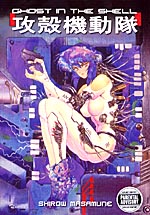 By Masamune Shirow
By Masamune Shirow
368 pages, black and white, with additional color
Published by Dark Horse
It’s always a little strange to finally read something that for so long has been considered a modern classic. After a while, people almost assume that you’ve read it, while you yourself can pick up some preconceptions on just what he work is like. That was very much the case for myself with Masamune Shirow’s Ghost in the Shell. With a new printing of the collection released late last year, the time to finally experience it seemed as good as any.
 In the year 2029, technology has advanced to the point where robots, cyborgs, and virtual hacking is commonplace. Amidst people who can “ghost” into other machines and even people, one of the best governmental operatives is Major Motoko Kusanagi. Even she will be unprepared for what this brave new world will lead her to discover, though.
In the year 2029, technology has advanced to the point where robots, cyborgs, and virtual hacking is commonplace. Amidst people who can “ghost” into other machines and even people, one of the best governmental operatives is Major Motoko Kusanagi. Even she will be unprepared for what this brave new world will lead her to discover, though.
Reading Ghost in the Shell, I was surprised to learn that the book is more a collection of short adventures and missions than an actual extended narrative about Kusanagi and her fellow operatives. It’s not until almost the very end of the book that the plot boasted on the back cover occurs, at which point I found myself almost despairing of the possibility of any sort of development or change in the status quo from one story to the next. It doesn’t help that the writing itself isn’t terribly focused; perhaps it’s an artifact of the translation, but most stories feel like they’re missing key elements. It’s a very scatter shot approach, with pieces of information just thrown across the page with a real lack of coherency or value. It’s hard to care what happens to characters or missions when you never feel like you’re getting to know anything about them. Major Kusanagi is a prime example; but the time she actually gets a storyline that really affects her at the end of the book, it’s hard to care about her fate on anything more than a technical level. It’s interesting to see what’s happening in a, “Wow, that’s neat” sort of way, but the character affected might as well have been a nameless extra; at the end of the book all I could tell you about Kusanagi, personality-wise, is that she’s very good at her job. The only thing about Ghost in the Shell‘s writing that did grab my attention was Shirow’s imagining and compiling of future technology concepts. He does a nice job of pulling a lot of his ideas together into a fully realized world where they exist, and there’s a lot of potential for future stories to be told within the framework.
 Shirow’s characters in Ghost in the Shell are pretty typically average; they’re not terribly attractive, featuring a real sameness of expression from one page to the next. This lack of emotion in his characters is certainly one of the hindrances to the writing, since you can never really get a sense of how the characters feel through the art. Where Shirow does succeed, though, is with the backgrounds and scenery of Ghost in the Shell. Shirow clearly loves drawing things like buildings, vehicles, and futuristic technology, and that’s where all of the real effort has gone. What other artists might have dashed off in a hurry, Shirow has lovingly illustrated, carefully crafting with each individual line. I may have found it hard to really care much about the characters of Ghost in the Shell, but Shirow drew their world so beautifully that It actually feels more alive and interesting to the point that it became the most interesting “character” in the book.
Shirow’s characters in Ghost in the Shell are pretty typically average; they’re not terribly attractive, featuring a real sameness of expression from one page to the next. This lack of emotion in his characters is certainly one of the hindrances to the writing, since you can never really get a sense of how the characters feel through the art. Where Shirow does succeed, though, is with the backgrounds and scenery of Ghost in the Shell. Shirow clearly loves drawing things like buildings, vehicles, and futuristic technology, and that’s where all of the real effort has gone. What other artists might have dashed off in a hurry, Shirow has lovingly illustrated, carefully crafting with each individual line. I may have found it hard to really care much about the characters of Ghost in the Shell, but Shirow drew their world so beautifully that It actually feels more alive and interesting to the point that it became the most interesting “character” in the book.
Shirow begins each of the chapters of Ghost in the Shell with a full-color sequence, and unlike most Japanese comics translated into English, Dark Horse has kept that color intact. It’s easy to see why; Shirow’s color art is really beautiful, and it means that the collection is a really sharp looking final product. It’s a shame that the book itself doesn’t read terribly well, and it does really make me wonder how this book became so legendary over the years. (Perhaps the feature-film is a significant improvement?) I’m glad I got to experience Shirow’s artistic view of the future and am a little interested in the idea of his Intron Depot art books, but on the whole Ghost in the Shell was a massive shell game: flashy and fascinating from a glance, but ultimately empty when you decide to dive in.
Purchase Links:
